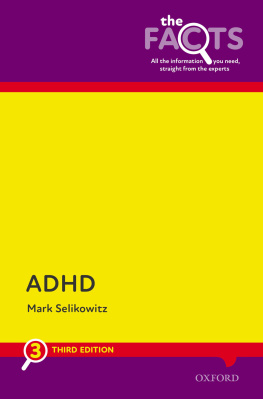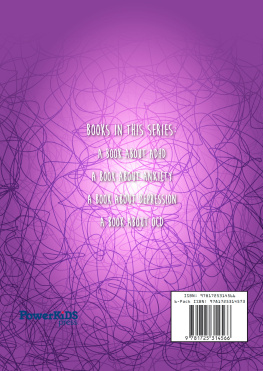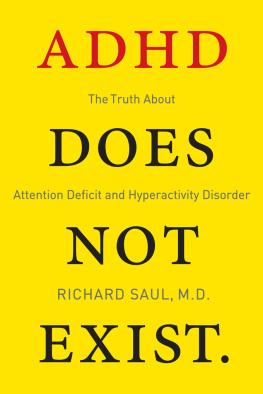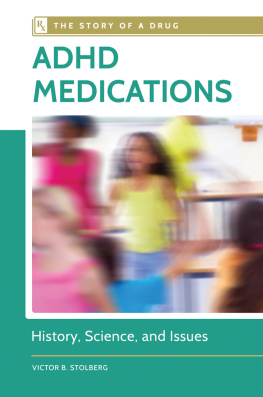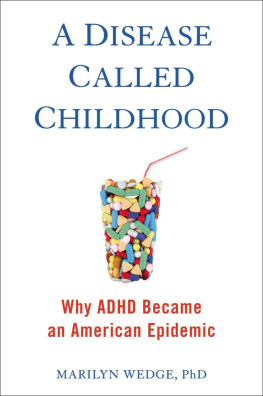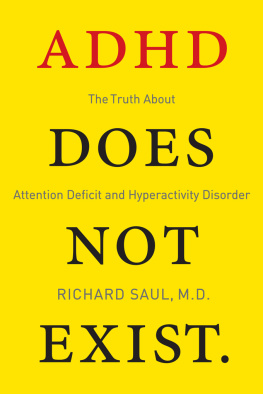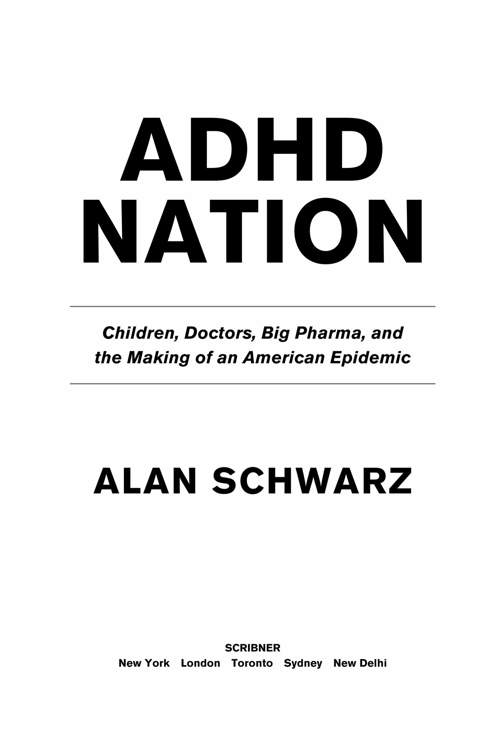Thank you for downloading this Scribner eBook.
Join our mailing list and get updates on new releases, deals, bonus content and other great books from Scribner and Simon & Schuster.
C LICK H ERE T O S IGN U P
or visit us online to sign up at
eBookNews.SimonandSchuster.com
CONTENTS
TO DAD
For my square roots
A trial of amphetamine therapy brought about striking behavioral changes, a decisive improvement in school performance, and a consequent uneasy peace among the warring factions. It was difficult to argue with success.
Leon Eisenberg
Minimal Brain Dysfunction in Children
June 1970
INTRODUCTION
Attention deficit hyperactivity disorder is real. Dont let anyone tell you otherwise.
A boy who careens frenziedly around homes and busy streets can endanger himself and others. A girl who cannot, even for two minutes, sit and listen to her teachers will not learn. An adult who lacks the concentration to complete a health-insurance form accurately will fail the demands of modern life. When a person of any age has a combination of these strugglesseverely enough to impair his daily functioningwith no other plausible explanation for them, then he could very well have a serious, if still somewhat mysterious, condition that medicine has decided to call ADHD.
No one quite knows what causes it. The most commonly cited theory is that the hyperactivity, lack of focus, and impulsivity of classic ADHD result from some sort of dysfunction among chemicals and synapses in the brain. A persons environment clearly plays a role as well: a chaotic home, an inflexible classroom, or a distracting workplace all can induce or exacerbate symptoms. Unfortunately, as with many psychiatric illnesses, such as depression or anxiety, there is no definitive way to diagnose ADHD, no blood test or CAT scan that lets a doctor declare, Okay, there it isall one can do is thoughtfully assess whether the severity of the behavior warrants a diagnosis. (After all, we all are distractible or impulsive to varying degrees.) One thing is certain, though: There is no cure for ADHD. Someone with the disorder might learn to adapt to it, perhaps with the help of medication, but patients young and old are generally told that they will deal with their abnormal brains for the rest of their lives.
As for medicationsfor a long time Ritalin and now primarily Adderall, Concerta, and Vyvansethey quite remarkably improve concentration and impulse control. Not unlike the painkiller OxyContin and antianxiety agents like Valium, they are powerful drugs that can be dangerous and addictive, particularly when taken improperly. All told, however, they have done considerably more good than harm; they are not the Devils work. If a diagnosis of ADHD has been made by a qualified and responsible health professional then the decision to seek treatment through medication, either for yourself or your child, is not unreasonable.
The American Psychiatric Associations official description of ADHD, codified by the fields top experts and used to guide doctors nationwide, says that the condition affects about 5 percent of children, primarily boys. Most experts consider this a sensible benchmark.
But whats happening in real-life America?
Fifteen percent of youngsters in the United States three times the consensus estimateare getting diagnosed with ADHD. Thats millions of extra kids being told they have something wrong with their brains, with most of them then placed on serious medications. The rate among boys nationwide is a stunning 20 percent. In southern states such as Mississippi, South Carolina, and Arkansas, its 30 percent of all boys, almost one in three. (Boys tend to be more hyperactive and impulsive than girls, whose ADHD can manifest itself more as an inability to concentrate.) Some Louisiana counties are approaching half half of boys in third through fifth grades taking ADHD medications.
ADHD has become, by far, the most misdiagnosed condition in American medicine.
Yet, distressingly, few people in the thriving ADHD industrial complex acknowledge this reality. Many are well-meaningthey see foundering children, either in their living rooms, classrooms, or waiting rooms, and believe the diagnosis and medication can improve their lives. Others have motives more mixed: Sometimes teachers prefer fewer troublesome students, parents want less clamorous homes, and doctors like the steady stream of easy business. In the most nefarious corner stand the high-profile doctors and researchers bought off by pharmaceutical companies that have reaped billions of dollars from the unchecked and heedless march of ADHD.
Some onlookers blame the new millenniums quick-fix, just-take-a-pill ethos, or simple Internet overload. But the rancor surrounding ADHD stretches back at least half a century, back to when the disorder carried the less marketable name of minimal brain dysfunction. A congressional hearing in 1970, not long after Ritalin emerged as a way to calm critically hyperactive children, examined whether too many kids were being put on behavior drugs. As the percentage of children diagnosed increased persistently through 2000, media reports staged recurrent tugs-of-war between parents testifying that Adderall was their familys lifeboat and those decrying the overmedication of children. Many claimed that this hostility only stigmatized kids with ADHD and discouraged parents from seeking help; then again, whatever stigma there was didnt prove very dissuasive. Diagnoses have continued to be handed out so blithely, at the hint of any problem, that today one in seven kids leave high school having been told they have ADHDno longer a niche minority but a sprawling swath of Americas future. Shockingly, its almost certain that kids misdiagnosed with ADHD outnumber those with the legitimate, clinical problem, leaving the disorder so muddied that no one quite knows what to make of it at all.
The ADHD explosion has become, to some, literally laughable. Stephen Colbert dubbed it Meducation, and profiled a doctor who prescribed Adderall to children without the disorder simply to improve their grades. Shocking! Colbert said. There are children in America who havent been diagnosed with ADHD. The Onion sardonically profiled a four-year-old girl stricken with Youthful Tendency Disorder. These ribbings are routinely decried by ADHD support groups as disrespectful. Perhaps, but some advocates also bring satire and skepticism upon themselves with preposterous sales messages, flitting back and forth from asserting the gravity of the condition (which one article says impair[s] life functioning 24/7) to celebrating its purported positives. Some Famous People with ADHD rosters claim that Thomas Edison, Abraham Lincoln, Galileoeven Socratesquite possibly suffered from ADHD, too, implying that it contributed to their inner genius and encouraging the hesitant to join their very good company. (That list now lives on a website surrounded by ads for ADHD medications.) The disorders longtime support and lobbying group, Children and Adults with Attention Deficit Hyperactivity Disorder (CHADD), has published its rundown of 12 Amazing ADHD Superpowers, among them Multitasking, Laser-focus, and A strong moral compass. Its a curious list, given that inability to stay on task and deficient focus are among the disorders official core symptoms.
Occupying a uniquely bizarre place in American culture, let alone medicine, ADHD has become the brain disorder some choose to fake. Because Adderall, Concerta, and other drugs can instantly boost any persons motivation and focus, whether for term papers or tax returns, the pills move from medicine to performance-enhancing drugs, steroids for the brain. Thus ADHD gets caught in a tenuous balancing act between treating the ill and tempting the healthyfostering spurious diagnoses not just among adults, who can take themselves to accommodating doctors, but children, too, because some parents will exaggerate their childs symptoms to get them a prescription. The doctor nods and says, Lets try Concerta and see if it helps; when it invariably does, and the childs schoolwork improves, the ADHD diagnosis appears confirmed. Yet the doctor might as well have said, Try these platform shoes, see if they make him taller.
Next page


